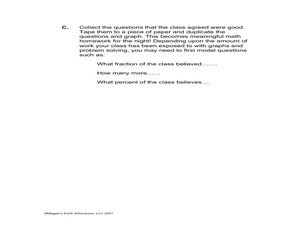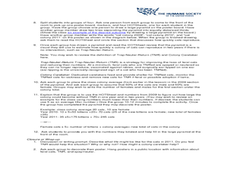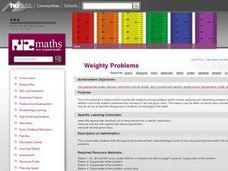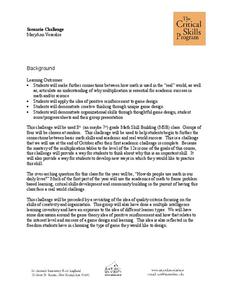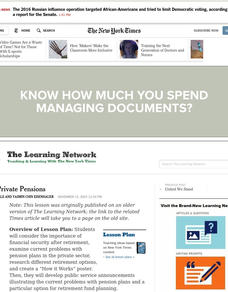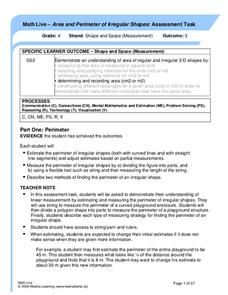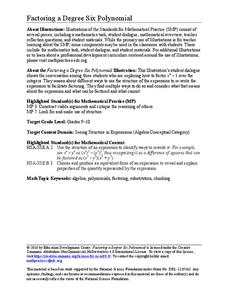Curated OER
Class Opinions on Renewable Energy
In this renewable energy worksheet, students put an X on their opinion on the energy source that will help the Earth's problems. Students have 5 energy sources to choose from and then complete math problems based on the results.
Curated OER
Journey of the Nez Perce
Students study the retreat of the Nez Perce Native Americans into Montana while tracing their journey on a map. They use the law of cosines to solve problems based on the navigational methods of the Nez Perce. They work with both the law...
Curated OER
The Tale of the Feral - Care and Multiplication of Feral Cats
Students differentiate between a feral cat and a domesticated cat. In this cat lesson plan, students use the scientific method, calculate averages, solve story problems, and learn how a caretaker can help a feral colony live safely.
Curated OER
Mobile vs. Money
Learners research the internet and use the information they find to plot straight line graphs. They use graphs to make comparisons of the various packages offered. Students interpret graphs and solve problems based on varying parameters.
Curated OER
Number Sense Sampler
First graders illustrate a math problem with counters while reading story books, such as Margie Burton's "Add the Animals". They demonstrate a positive learning attitude toward mathematics and communicate clearly in oral, artistic,...
Curated OER
Academic Challenge
Students apply their knowledge of math to the real world. In this algebra instructional activity, students explore different way to incorporate math topics into the real world. They create a score or progress sheet to mark their progress.
Curated OER
Bouncing off the Wall
Students watch a video clips before problem solving the use of angles in real world situations. They problem solve using spatial reasoning while connecting math to a sports activity that investigates the path of a bouncing ball.
Curated OER
Public Land
Students examine the needs of their community for public space and determine the solutions to math problems related to planning landscape designs. They read and discuss an article from the New York Times, create their own designs for a...
Curated OER
Natural Inspiration
Students relate math to the real world. In this algebra lesson plan, students compare plants to math and relate their artistic ability to concepts in math. They draw pictures of flowers, leaves and trees.
Curated OER
Stationery
In this secondary mathematics activity, high schoolers determine the number of sheets of paper in two stationery boxes based on the amount used by the two owners of the boxes. The one page activity contains one problem with the...
Curated OER
It's About Time!
Young scholars examine the potentials, both positive and negative, of adapting an international 'Internet time' system. They create and solve word problems that require them to translate between the current time system and Internet time.
Curated OER
LET'S PARTY!
Students identify a number pattern and extend the number sequence. They make generalizations given a specific pattern and create, describe, and extend patterns. They create a table that describes a function rule for a single operation...
Curated OER
Mass: Applying and Interpreting
Young scholars rotate through six studying stations solving problems that involve applying and interpreting aspects of mass. They solve various word problems, and measure the contents of cans and calculate the mass of two cans.
Curated OER
Scenario Challenge
Young scholars apply their knowledge of math to the real world. In this algebra lesson plan, students explore different way to incorporate math topics into the real world. They create a score or progress sheet to mark their progress.
Curated OER
Saving Private Pensions
Students consider the importance of financial security after retirement, examine current problems with pension plans in the private sector, research different retirement options, and create a "How it Works" poster.
Curated OER
Area and Perimeter of Rectangles
Discover the difference between area and perimeter. Learners are grouped in twos and threes and each group has one advanced/gifted learner to serve as the peer helper. They receive manipulatives to help them determine the area and...
Virginia Department of Education
Numbers in a Name
What's in a name? Pupils create a data set from the number of letters in the names of classmates. Each group then takes the data and creates a visual representation, such as a histogram, circle graph, stem-and-leaf plot, etc.
Kenan Fellows
Lego Thinking and Building
Run a simulated airplane manufacturing plant with your pupils as the builders! Learners build Lego airplane models and collect data on the rate of production, comparing the number produced to the number defective. Using linear...
EngageNY
Experiments with Inscribed Angles
Right angles, acute angles, obtuse angles, central angles, inscribed angles: how many types of angles are there? Learners first investigate definitions of inscribed angles, central angles, and intercepted arcs. The majority of the...
EngageNY
Relationships Between Two Numerical Variables
Working in small groups and in pairs, classmates build an understanding of what types of relationships can be used to model individual scatter plots. The nonlinear scatter plots in this activity on relationships between two numerical...
Mathematics Vision Project
Module 1: Getting Ready Module
This fabulous resource is a must-have for any algebra teacher's arsenal of lessons. Developing the idea of equations and use of variables from basic physical scenarios, learners gain valuable intuition in the structure and meaning of...
Alberta Learning
Area and Perimeter of Irregular Shapes
Evaluate young mathematicians' understanding of area and perimeter with this series of three assessment tasks. Challenging students to not only calculate the area and perimeter of irregular shapes, but to explain in writing their...
Education Development Center
Making Sense of Unusual Results
Collaboration is the key for this equation-solving lesson. Learners solve a multi-step linear equation that requires using the distributive property. Within collaborative groups, scholars discuss multiple methods and troubleshoot mistakes.
Education Development Center
Factoring a Degree Six Polynomial
Within collaborative groups, scholars factor a degree six polynomial. They can factor the polynomial using many different strategies — a great way to prompt mathematical discussion.
